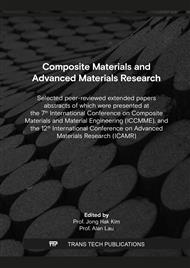[1]
K.Panas, A.Łukaszewicz, Effective work in design of new product in MCAD systems. Machine Dynamics Research, Vol. 37, nr 3 (2013), s. 45-52.
Google Scholar
[2]
Łukaszewicz, Z. Koruba , Scientific aspects of unmanned mobile vehicle. Polish Society of Theoretical and Applied Mechanics, 145, (2010).
Google Scholar
[3]
Mohammadzadeh, B.; Jung, S.; Lee, T.H.; Le, Q.V.; Cha, J.H.; Jang, H.W.; Lee, S.-H.; Kang, J.; Shokouhimehr, M. Manufacturing ZrB2–SiC–TaC Composite: Potential Application for Aircraft Wing Assessed by Frequency Analysis through Finite Element Model. Materials , 13, 2213. (2020).
DOI: 10.3390/ma13102213
Google Scholar
[4]
C. Kassapoglou, Design and Analysis of Composite Structures with Applications to Aerospace Structures, Wiley, (2013).
Google Scholar
[5]
A. Fiorina, B. Seman, K. M. Castanie, Ali C, Schwob and L. Mezeix, Spring-in prediction for carbon/epoxy aerospace composite structure, Composite Structures. 168,739–745, (2017).
DOI: 10.1016/j.compstruct.2017.02.074
Google Scholar
[6]
F. H. Darwish, G. M. Atmeh, Z. F. Hasan, Analysis and Modelling of a General Aviation Aircraft, Jordan Journal of Mechanical & Industrial Engineering .6, 183–19, (2019).
Google Scholar
[7]
R. Rimašauskiene˙ a, V. Jure ˙ nasa, M. Radzienskib, M. Rimašauskasa, W. Ostachowiczb, Experimental analysis of active–passive vibration control on thin-walled composite beam, Compos. Struct. 223, (2019).
Google Scholar
[8]
A. Mark Kamel, K. Ibrahim, A. Ahmed, Vibration control of smart cantilever beam using finite element method, Alexandria Eng. J. 58 591–601, (2019).
DOI: 10.1016/j.aej.2019.05.009
Google Scholar
[9]
J.R. Banerjee, H. Sua, C. Jayatunga, A dynamic stiffness element for free vibration analysis of composite beams and its application to aircraft wings, Comp. Struct. 86 573–579, (2008).
DOI: 10.1016/j.compstruc.2007.04.027
Google Scholar
[10]
V. Phadnis, A. Roy, V. Silberschmidt, Finite element analysis of drilling in carbon fiber reinforced polymer composites. Journal of Physics Conference Series. 382. 1-8. 10.1088/1742-6596/382/1/012014, (2012).
DOI: 10.1088/1742-6596/382/1/012014
Google Scholar
[11]
A. Nikhil Khadse and S. R. Zawari, Modal Analysis of Aircraft Wing using Ansys, International Journal of Engineering Research & Technology, Vol. 4, No. 7, 225-230, (2015).
Google Scholar
[12]
S. Senthilkumar, A. Velayudham and P. Maniarasan, Dynamic Structural Response of an Aircraft Wing Using Ansys, International Journal of Engineering Research & Technology, 2. 6, 1609-1612, (2013).
Google Scholar
[13]
J.R. Banerjee, H. Sua, C. Jayatunga, A dynamic stiffness element for free vibration analysis of composite beams and its application to aircraft wings, Comp. Struct. 86. 573–579, (2008).
DOI: 10.1016/j.compstruc.2007.04.027
Google Scholar
[14]
P. Agrawal, P. Dhatrak, P. Choudhary, Comparative study on vibration characteristics of aircraft wings using finite element method, Materials Today: Proceedings,(2020).
DOI: 10.1016/j.matpr.2020.07.229
Google Scholar
[15]
S. Tauseef, R.K. Agrawal, Active vibration control of smart cantilever beam, Imperial J. Interdisciplinary Res. (IJIR) 2 (5) (2016).
Google Scholar
[16]
S. E. Günaslan, A. Karas in, M.E. Öncü, Properties of FRP materials for strengthening, Int. J. Innov. Sci. Eng. Technol. 1 (9) 656–660, (2014).
Google Scholar
[17]
E. Gudonis, E. Timinskas, V. Gribniak, G. Kaklauskas, A. Arnautov, V. Tamulėnas, FRP reinforcement for concrete structures: State-of-the-art review of application and design, Eng. Struct. Technol. 5 (4) 147–158, (2013).
DOI: 10.3846/2029882x.2014.889274
Google Scholar
[18]
W. Grodzki, Andrzej Łukaszewicz, Design and manufacture of umanned aerial vehicles (UAV) wing structure using composite materials. Materialwissenschaft und Werkstofftechnik. 46. 10.1002/mawe.201500351, (2015).
DOI: 10.1002/mawe.201500351
Google Scholar
[19]
P. J., Rol, D. N., Marris, and D. P., Schrage, Combined Aerodynamic and Structural Optimization of a High-Speed Civil Transport Wing, School of Aerospace Engineering, American Institute of Aeronautic and Astronautic, Inc.,(1995).
DOI: 10.2514/6.1995-1222
Google Scholar
[20]
M. R., Gargan, The Optimum Structural Design of Aircraft Wing by using Finite Element Method, Thesis, University of Technology, (2001).
Google Scholar



